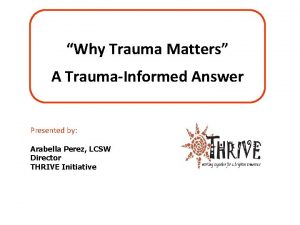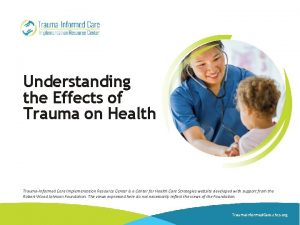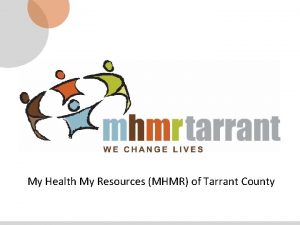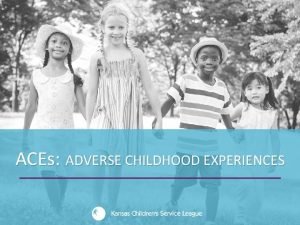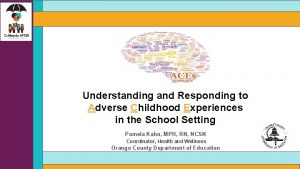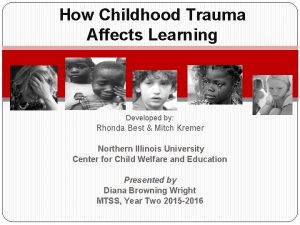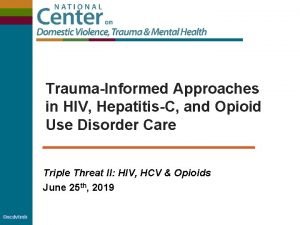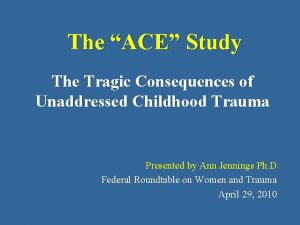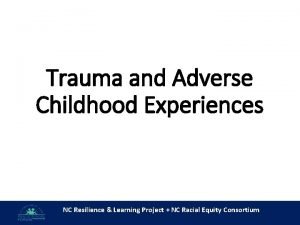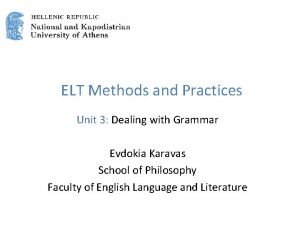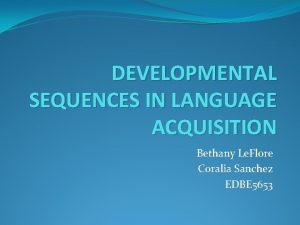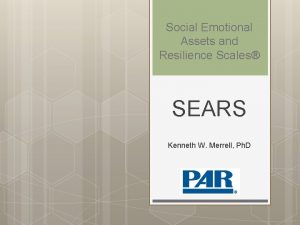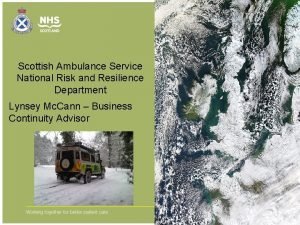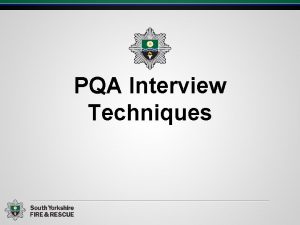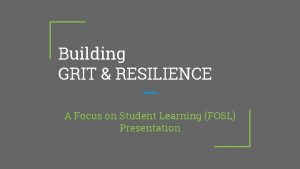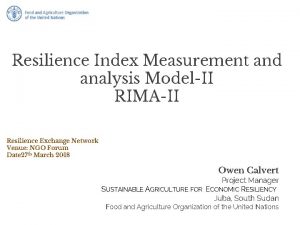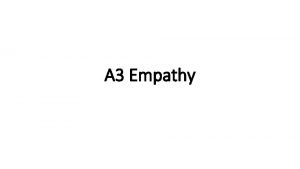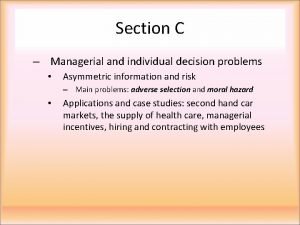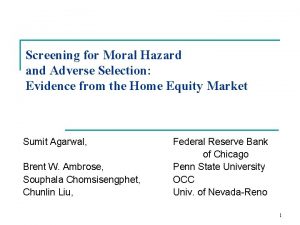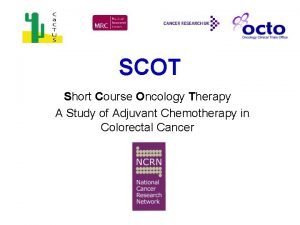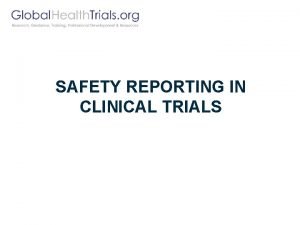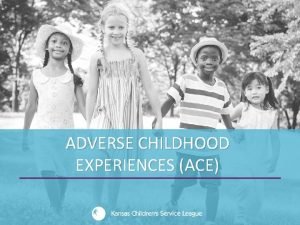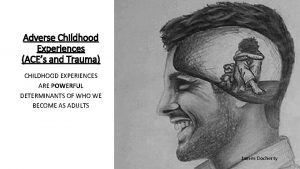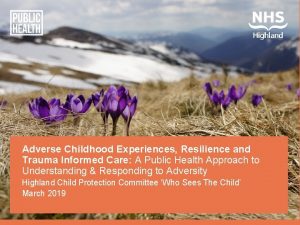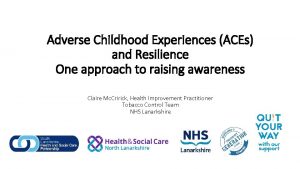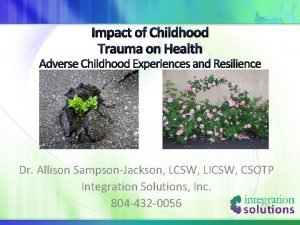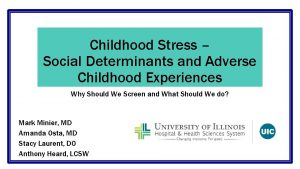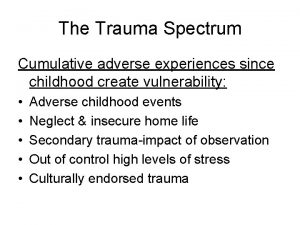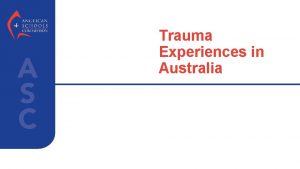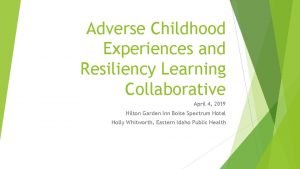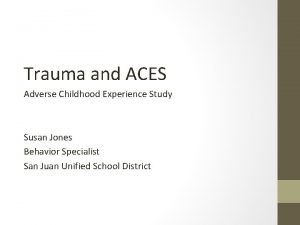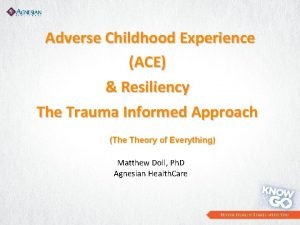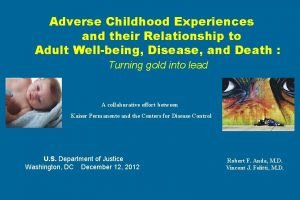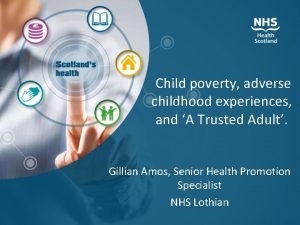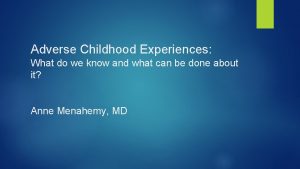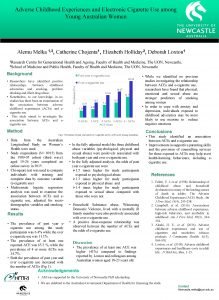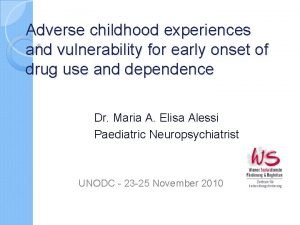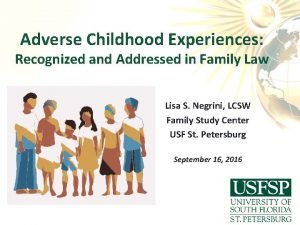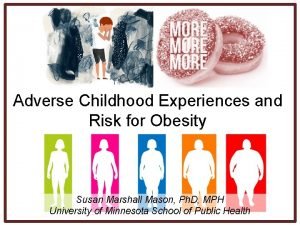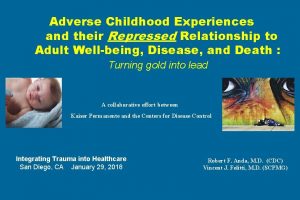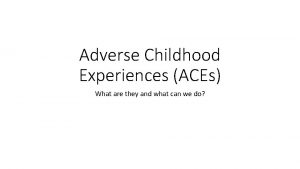Trauma and Adverse Childhood Experiences NC Resilience Learning

























- Slides: 25

Trauma and Adverse Childhood Experiences NC Resilience & Learning Project + NC Racial Equity Consortium

Study Group XVI Overview Kicked off in October 2015 – Expanding Educational Opportunity in NC Divided work in three committees – Racial Equity, Trauma & Learning, Low Performing Schools 176 committee members; 327 members and guests attended one or more committee meetings. Attendees represent diverse backgrounds and perspectives (teachers, principals, legislators, superintendents, members of local school boards, business leaders, researchers, and other education professionals and advocates) Completed work Summer of 2016 and released final report and recommendations in October 2016. NC Resilience & Learning Project + NC Racial Equity Consortium

Trauma & Learning NC Resilience & Learning Project + NC Racial Equity Consortium

What is Trauma? • Trauma may be a response resulting from: • A one-time event OR • A chronic situation • Vicarious experiences that are repeated • Trauma can be the result of a number of categories of events such as: • • • Poverty/homelessness/lack of basic needs Exposure to violence Physical, sexual, or emotional maltreatment Chronic neglect Caregiver substance abuse or mental illness Loss of caregiver (e. g. , incarceration, custody change, death, parents serving overseas) NC Resilience & Learning Project + NC Racial Equity Consortium

What is Trauma? “Trauma is not an event itself, but rather a response to a stressful experience in which a person’s ability to cope is dramatically undermined” Cole, S. F. , O’Brien, J. G. , Gadd, M. G. , Ristuccia, J. , Wallace, D. L. , Gregory, M. (2005). Helping Traumatized Children Learn. Boston, MA: Massachusetts Advocates for Children, pp. 18. NC Resilience & Learning Project + NC Racial Equity Consortium

What are ACEs? • ACEs: Adverse Childhood Experiences • In 1995 -1997, the largest study ever conducted on ACEs was done by the CDC and Kaiser-Permanente in California and included over 17, 000 participants • The ACE Questionnaire includes 10 questions about 10 different adverse childhood experiences https: //www. cdc. gov/violenceprevention/acestudy/about. html NC Resilience & Learning Project + NC Racial Equity Consortium

Lets Take The ACE Quiz For Ourselves http: //www. npr. org/sections/health-shots/2015/03/02/387007941/take-the-ace-quiz-and -learn-what-it-does-and-doesnt-mean https: //www. cdc. gov/violenceprevention/acestudy/about. html NC Resilience & Learning Project + NC Racial Equity Consortium

What did the ACE study find? Out of the over 17, 000 participants: • 64% reported at least ONE ACE § 26% reported ONE ACE § 16% reported TWO ACEs § 9. 5% reported THREE ACEs § 12. 4% reported FOUR OR MORE ACEs https: //www. cdc. gov/violenceprevention/acestudy/about. html NC Resilience & Learning Project + NC Racial Equity Consortium

Impacts of ACEs / Trauma Exposure NC Resilience & Learning Project + NC Racial Equity Consortium

What is the impact of trauma and toxic stress? • Toxic stress is caused by prolonged or pronounced stress that overwhelms children’s skills or support • This causes children to go into “survival mode” or remain in a state of “stress response” • Being in this state on a regular basis actually alters the chemical and neurological events in a child’s brain NC Resilience & Learning Project + NC Racial Equity Consortium

Chemical Reactions in the Brain • When a child experiences toxic stress: • Stress hormones (such as cortisol) are released and remain at high levels • This causes chemically toxic effects on brain regions involved in problem solving and decision-making • This toxic chemical reaction enhances functioning in emotional parts of the brain that respond instinctively to threat NC Resilience & Learning Project + NC Racial Equity Consortium

Brain Development • “Downstairs Brain” – Limbic System that controls: • Arousal • Emotions • The body’s physical response to stress (fight, flight, freeze) • When the “downstairs brain” is continually working to respond to stress and danger, it is hard for a child to switch to using parts of the brain needed for academic learning • “Upstairs Brain” – Prefrontal Cortex that controls functions needed for learning: • • • Ability to think and reason Ability to take in new information Memory Ability to make decisions calmly Ability to focus attention Impulse control Souers, K. & Hall, P. (2016). Fostering Resilient Learners. Alexandria, VA: ASCD. NC Resilience & Learning Project + NC Racial Equity Consortium

Think about a time… • Have you ever been driving and focused on one thought – maybe your grocery list, what to cook for dinner, your first to-do item at work that day – and all of a sudden someone cuts you off or you have to suddenly slam on your brakes? • What does your mind do in that moment? • What does your body do in that moment? • Are you able to easily go back to the task you were originally thinking about? This is how children with trauma may feel ALL the time. NC Resilience & Learning Project + NC Racial Equity Consortium

Fight, Flight, Freeze Response • The limbic system (“downstairs brain”) lets the body know when it is in danger and tells it to respond in one of three ways: • Fight: verbal and physical aggression or defiance • Flight: instinct to run and escape the danger • Freeze: wanting to shut down, withdraw, or become invisible • In normal situations, the limbic system keeps us safe, but for a child with trauma, this can become a constant state of being for them • These three responses are seen in a wide range of behaviors in kids How have you seen the fight, flight, or freeze response in children in your classes? NC Resilience & Learning Project + NC Racial Equity Consortium

What Does This Look Like in Schools? NC Resilience & Learning Project + NC Racial Equity Consortium

Impact of Trauma is Seen in: Learning & Academic Performance Classroom Behavior Relationships – peers/teachers NC Resilience & Learning Project + NC Racial Equity Consortium

Impacts on the Whole School Students impacted by ACEs tend to: • Receive more office/discipline referrals • Have Increased suspension and expulsion rates • Have Lower academic performance – lower test scores, including Reading • Have Higher retention rates • Have Poorer attendance and tardiness rates NC Resilience & Learning Project + NC Racial Equity Consortium

Impacts on the Whole School Students impacted by ACEs tend to: • Have Slowed language development • Be more likely to have Attention problems (ADD/ADHD) • Have Speech delays • Experience Poor verbal memory/recall • Experience a Physical shrinkage of the brain NC Resilience & Learning Project + NC Racial Equity Consortium

Impacts on the Whole School Students impacted by ACEs tend to: • Be at 2 ½ times greater risk to fail a grade. • Score lower on standardized tests. • Have language difficulties. • Be suspended or expelled more often. • Be designated to special education more frequently. • Have poorer health. NC Resilience & Learning Project + NC Racial Equity Consortium

ACEs Videos • • https: //www. youtube. com/watch? v=We 2 Bqmj. HN 0 k&list=PL 8 u. X 4 Xr_dk. Jk 8 S 6 GR X 04 u. VJUQGrq. ZZjj. X • https: //www. youtube. com/watch? v=cc. KFkcf. Xx-c • https: //www. youtube. com/watch? v=Wuy. Pu. H 9 oj. CE • https: //www. youtube. com/watch? v=95 ov. IJ 3 ds. Nk&list=PL 6 YEF 9 Pf. Ej. IC 1 A 7 Joku. Xk 2 CFVnh. FTHtf&index=3 NC Resilience & Learning Project + NC Racial Equity Consortium

NC Resilience & Learning Project: How it will work • Two key components: • Professional Development: Ø Training for the entire staff school-wide (should include ANY school staff who interact with students) Ø More in-depth training for the Resilience Team • Resilience Team: Ø A team within each school that will meet bi-weekly throughout the year to identify areas of urgency and work through a focused action planning process to create strategies that will make your school trauma-sensitive NC Resilience & Learning Project + NC Racial Equity Consortium

How we can start: Shifting our view • Promote WHOLE school WHOLE child approach that is a total culture shift within the school – looking at a child thinking “What happened to you? ” instead of “What is wrong with you? ” Traditional View Trauma-informed View Impulsive Difficulty regulating emotions Aggressive/Defiant Trauma response triggered, trying to gain control and find safety Withdrawn/”unmotivated” Afraid, overwhelmed, world is a dangerous place Over-reacting Seeking to get needs met ADHD Lacking necessary skills Reaction: STUDENT NEEDS TO BE PUNISHED Reaction: STUDENT NEEDS SKILLS AND SUPPORT NC Resilience & Learning Project + NC Racial Equity Consortium

Do Trauma-Sensitive Schools Matter? NC Resilience & Learning Project + NC Racial Equity Consortium

Early Findings on Trauma. Sensitive Schools Decrease in: • Student depression symptoms • Behavioral outcomes after 1 year: • Suspension rates by 30 -90% • Office referral rates by 20 -44% • Incidents of physical aggression by 43% • Behavioral outcomes after 5 years: • Suspension rates by 95% Dorado, et al (2016) & Stevens (2012) NC Resilience & Learning Project + NC Racial Equity Consortium

Early Findings on Trauma. Sensitive Schools Increase in: • Student self-esteem • Academic outcomes: • • Students’ ability to learn by 28% Student time on task while in class by 27% School attendance rate by 34% Test scores Dorado, et al (2016) & Stevens (2012) NC Resilience & Learning Project + NC Racial Equity Consortium
 Adverse childhood experiences study
Adverse childhood experiences study Adverse childhood experiences study
Adverse childhood experiences study Mhmr of tarrant county
Mhmr of tarrant county Adverse childhood experiences powerpoint
Adverse childhood experiences powerpoint What are adverse childhood experiences
What are adverse childhood experiences Middle and late childhood
Middle and late childhood Childhood trauma discussion questions
Childhood trauma discussion questions Gabriela zapata alma
Gabriela zapata alma Ace test score interpretation
Ace test score interpretation Nc resilience and learning project
Nc resilience and learning project Meaningful learning experiences examples
Meaningful learning experiences examples Cuadro comparativo e-learning y b-learning
Cuadro comparativo e-learning y b-learning Developmental sequences in language acquisition
Developmental sequences in language acquisition A vygotskian classroom promotes ________.
A vygotskian classroom promotes ________. Sears assessment
Sears assessment National risk and resilience ambulance
National risk and resilience ambulance Pqa example answers
Pqa example answers Building grit and resilience
Building grit and resilience Resilience index measurement and analysis
Resilience index measurement and analysis Robert vischer empathy theory advantages
Robert vischer empathy theory advantages Adverse reaction definition
Adverse reaction definition Near miss sentinel event
Near miss sentinel event Adverse selection
Adverse selection Adverse selection
Adverse selection Adverse reaction definition
Adverse reaction definition Adverse reaction definition
Adverse reaction definition
